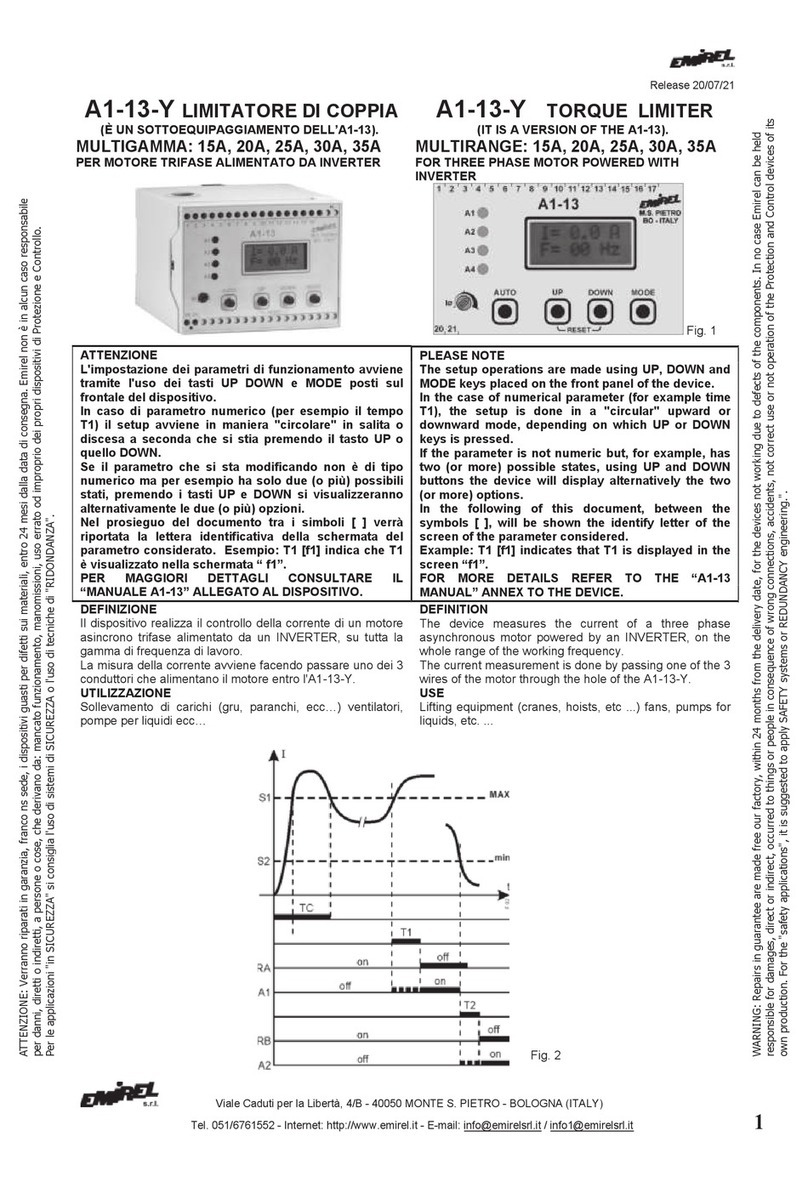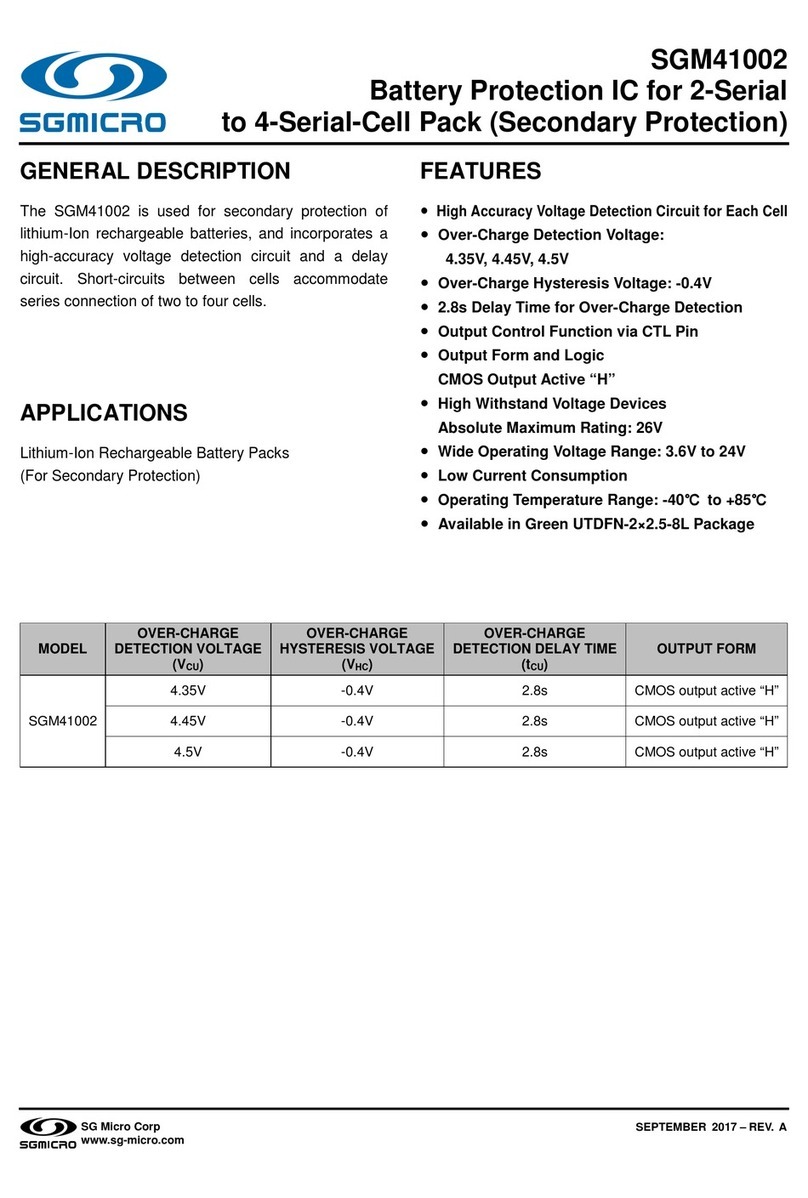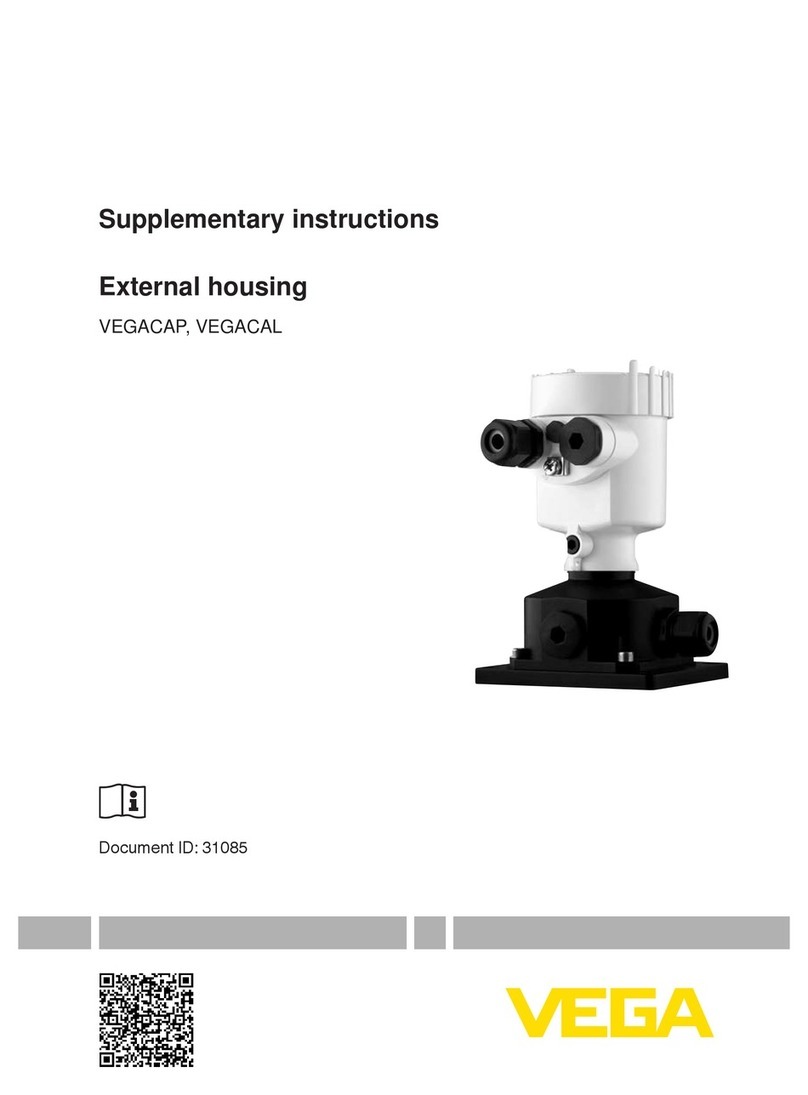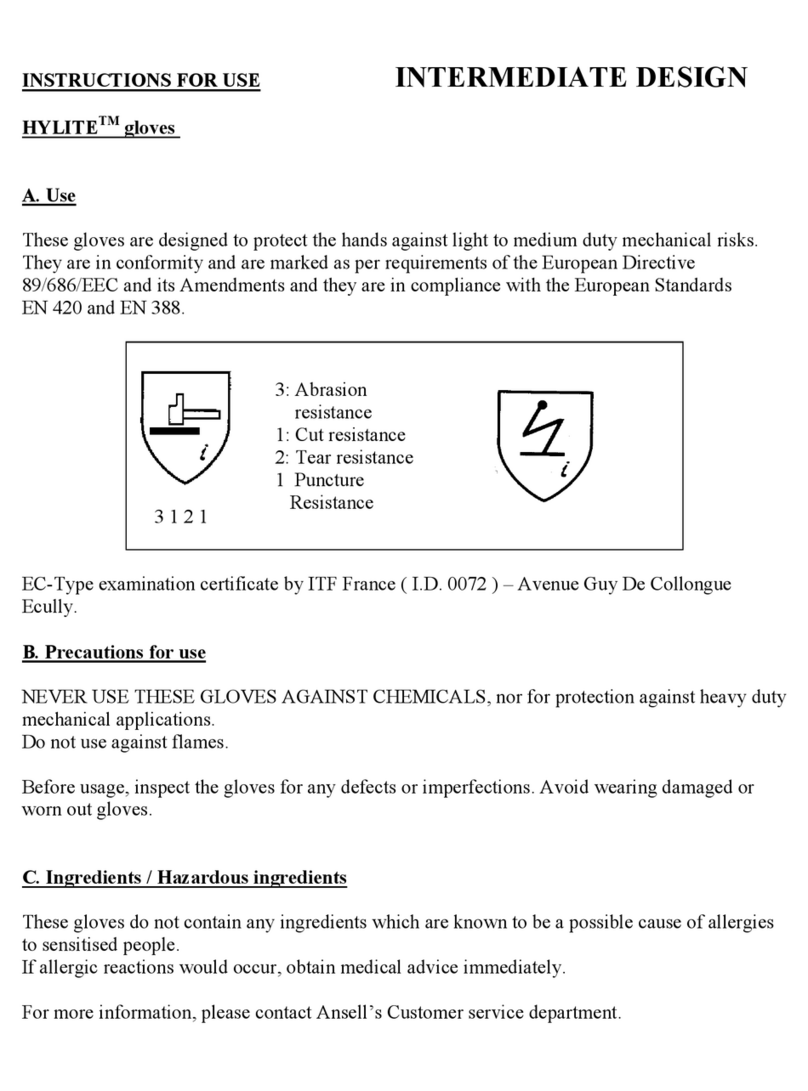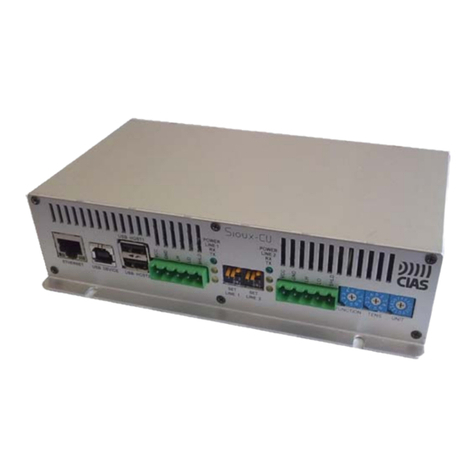Emirel E 404-1 User manual

Viale Caduti per la Libertà, 4b - 40050 MONTE S. PIETRO - BOLOGNA (ITALY) –
Tel. 051/6761552 - Fax 051/6760492 - Internet: http://www.emirel.it - E-mail: info@emirelsrl.it – info1@emirelsrl.it 1
Release 20/02/19
LIMITATORE DI CARICO
Multigamma a inserzione diretta
5-15-25-40A (1,5kW÷21kW)
DEFINIZIONE
Controlla la potenza assorbita da un motore a due polarità.
UTILIZZAZIONE
Per la limitazione del peso sollevato.
CARATTERISTICHE E REGOLAZIONI
S
Soglia di intervento LENTA: impostabile sul frontale
mediante COMMUTATORI a predeterminazione. E’ divisa in
100 parti e rappresenta la percentuale del fondo scala (in
potenza). Gamma di impostazione 10-99 – soglia minima
10%.
F
Soglia di intervento VELOCE: impostabile sul frontale
mediante commutatori a predeterminazione. E’ diviso in 100
parti e rappresenta la percentuale del fondo scala (in
potenza). Gamma di impostazione 10-99 – soglia minima
10%.
NOTA 1
Le soglie S e F hanno un ritardo fisso di 100ms circa.
GAMMA DI CORRENTE
In funzione delle correnti di targa del motore (I) veloce, (I)
lenta, bisogna scegliere un fondo scala di corrente per le 2
OVERLOAD PROTECTOR
Multirange Direct insertion
5-15-25-40A (1,5kW÷21 kW)
FUNCTION
It detects the active power of a two-speed motor.
USE
It is used to limit the hoisted load.
TECHNICAL FEATURES AND REGULATIONS
S
SLOW set point: adjustable by commutators on the front
panel. The scale is divided in 100 steps and it represents
the percentage of the selected full scale (kW).
Setting range 10-99 - minimum set point 10%.
F
FAST set point: adjustable by commutators on the front
panel. The scale is divided in 100 steps and it represents
the percentage of the selected full scale (kW).
Setting range 10-99 - minimum set point 10%.
REMARK 1
The set point S and F are delayed for a fixed period of
100ms.
CURRENT RANGE
The current ranges for the two speeds: (I) fast and (I) slow
have to be selected ac-cording to the motor plate current.
ATTENZIONE: Verranno riparati in garanzia, franco ns sede, i dispositivi guasti per difetti sui materiali, entro 12 mesi dalla data di consegna. Emirel non è in alcun caso responsabile
per danni, diretti o indiretti, a persone o cose, che derivano da: mancato funzionamento, manomissioni, uso errato od improprio dei propri dispositivi di Protezione e Controllo.
Per le applicazioni "in SICUREZZA" si consiglia l'uso di sistemi di SICUREZZA o l'uso di tecniche di "RIDONDANZA".
WARNING: Repairs in guarantee are made free our factory, within 12 months from the delivery date, for the devices not working due to defects of the components. In no case Emirel
can be held responsible for damages, direct or indirect, occurred to things or people in consequence of wrong connections, accidents, not correct use or not operation of the Protection and
Control devices of its
own production. For the "safety applications", it is suggested to apply SAFETY systems or REDUNDANCY engineering.".
TAB. A
VELOCE / FAST LENTO / SLOW
GAMMA
RANGE
(A)
POTENZA
POWER
Kw/400Vac
TA
CT
CAV.
LINKS GAMMA
RANGE
POTENZA
POWER
Kw/400Vac
TA
CT
CAV.
LINKS
0,5 – 5
1,5 – 15
2,5 – 25
4 – 40
50 A
75 A
100 A
150 A
0,22 – 2,2
0,7 – 7
1,3 – 13
2,1 – 21
3,4 – 34,5
5,1 – 51,7
6,9 – 69,0
10,3
–
103,5
---
---
---
---
50/5
(*)150/5
100/5
150/5
28 – 32
18 – 31
28 – 30
28 – 29
28 – 32
28 – 32
28 – 32
28
–
32
0,5 – 5
1,5 – 15
2,5 – 25
4 – 40
50 A
75 A
100 A
150 A
0,22 – 2,2
0,7 – 7
1,3 – 13
2,1 – 21
3,4 – 34,5
5,1 – 51,7
6,9 – 69,0
10,3
–
103,5
---
---
---
---
50/5
(*)150/5
100/5
150/5
34 – 38
34 – 37
34 – 36
34 – 35
34 – 38
34 – 38
34 – 38
34
–
38
(*) Nota: sono richiesti 2 giri nel TA – Fig. 7
Remark: 2 windings inside the CT are request – Fig. 7
(*) Nota: sono richiesti 2 giri nel TA – Fig. 7
Remark: 2 windings inside the CT are request – Fig. 7
E 404-1

Viale Caduti per la Libertà, 4b - 40050 MONTE S. PIETRO - BOLOGNA (ITALY) –
2Tel. 051/6761552 - Fax 051/6760492 - Internet: http://www.emirel.it - E-mail: info@emirelsrl.it – info1@emirelsrl.it
velocità.
Nella Tab. A sono riportate le gamme ed i cavallotti da
eseguire.
Esempio: (I) veloce= 11A - (I) lenta=2A. Per la veloce si
sceglie la gamma 1,5-15A e si esegue il cavallotto fra i
morsetti 28-31. Per la lenta si sceglie la gamma 0,5-5A e si
esegue il cavallotto 34-38.
Per le correnti > 40A occorre il TA esterno /5 (v. Fig.4). Nel
foro del dispositivo si farà passare il filo del secondario del
TA esterno, dopo avere eseguito il cavallotto corrispondente
alla gamma 0,5-5A.
Il valore di fondo scala della corrente può essere superato
anche del 30%, purchè il valore dell’uscita analogica (UA)
resti minore di 10Vdc, con il motore a pieno carico. (Se
l’uscita analogica fosse maggiore di 10Vdc, il dispositivo
sarebbe in allarme anche con i set point al massimo).
Esempio: il fondo scala 5A può lavorare anche con corrente
massima di 6,5A.
Le potenze indicate in TAB.A sono per riferimento, in quanto
il fondo scala va scelto in funzione della corrente nominale
assorbita dal motore nelle due condizioni (LENTA e
VELOCE), mentre la potenza dipende anche dalla tensione.
TCL
Tempo di cecità LENTO (0÷1 sec) temporizzatore regolabile
a cacciavite sul frontale. Rende cieca la soglia LENTA
quando si instaura la corrente e permette di superare il
picco di corrente che si presenta all’accensione del motore.
Si attiva tutte le volte che la corrente supera il 10% del
fondo scala della corrente. E’ diviso in 4 parti.
NOTA 2
II numeri 1÷4 riportati per TCL, TR, TCV, non sono secondi !
Indicano le parti in cui é divisa la scala. II fondo scala dei
tempi sono indicati sull’etichetta.
TR
Tempo di ritardo (0÷1 sec) temporizzatore regolabile a
cacciavite sul frontale. E’ attivato dalla fine di TCL; quindi si
somma a TCL ed assieme ritardano l’eccitarsi di RB
(l’eccitazione di RB passerà il motore in VELOCE). E’ diviso
in 4 parti. Durante TR può avvenire l’intervento nella fase
LENTA.
TCV
Tempo di cecità VELOCE (0÷2 sec) temporizzatore
regolabile a cacciavite sul frontale. Rende cieca la soglia
VELOCE quando si instaura la corrente e permette di
superare il picco di corrente che si presenta nella fase
VELOCE. Si attiva tutte le volte che la corrente supera il
10% del fondo scala. E’ diviso in 4 parti.
VISUALIZZAZIONI
ON LED VERDE dispositivo alimentato.
ALED ROSSO ALLARME: indica l’intervento del relè A
per supero di soglia (LENTA o VELOCE)
o per eccesso di partenze.
RIPRISTINO
Avviene alimentando il dispositivo con una tensione
alternata 20÷230Vac fra pin 17 e 19 per almeno 0,5 sec. Si
può utilizzare una tensione continua con il + sul 19.
E’ bene che il ripristino sia abbinato al comando di discesa,
per evitare il sollevamento di carichi eccessivi, sfruttando
più volte la presenza di TCL.
FUNZIONAMENTO
Il dispositivo sarà collegato come da schema di fig.
3,4,5,6,9, per cui il motore partirà sempre in LENTA. Alla
partenza si ha la situazione di fig. 1: durante il TCL non può
avvenire l’ALLARME. Al termine di TCL parte il tempo TR,
durante questo tempo può avvenire l’intervento del RELE’
“A” (PER SUPERO DELLA SOGLIA LENTA IMPOSTATA).
Se non é avvenuto l’intervento, al termine di TR si eccita il
RELE’ “B” che provoca il passaggio da LENTO a VELOCE e
parte il TCV. Durante TCV non può avvenire l’ALLARME.
Al termine di TCV può avvenire l’intervento del RELE’ “A”
per supero della soglia VELOCE (anche il RELE’ “B” cadrà).
NOTA 3
Il dispositivo é dotato di un controllo contro le partenze
troppo frequenti. Se vengono eseguite 9 partenze
Tab A. shows the ranges and the links to be made.
Example: (I) fast= 11A - (I) slow=2A. For the fast, the
range 1,5-15A is selected and the link is made between
the pins 28-31. For the slow the range 0,5-5A is selected
and the link 34-38 is made.
For the currents > 40A the external CT /5 is requested
(see Fig. 4). The CT has 2 pins for the secondary current:
a wire must be connected to one of the 2 pins, must pass
inside the hole of the E 404-1 and must be connected to
the second pin. The motor current may be 30% greater
then full scale value, provided that the analog output is
lower than 10 Vdc, when the motor is charged. If the
analog output is higher than 10Vdc, the device is in alarm
also with the set point at the maximum). Example: the full
scale 5A can work up to a maximum current of 6,5A.
The power values showed in TAB.A. are for reference
only, since the full scale is selected on base of the
nominal current of the motor in the two conditions (FAST
and SLOW), while the power depends also on the voltage
TCL
SLOW Initial timer (0÷1 sec) adjustable by the screwdriver
on the front. It is used to bypass the SLOW set point
when the current starts up and avoids the alarm during the
current spike of the motor. It is active every time the
current overcomes the 10% of the current value of full
scale.
It is divided in 4 parts.
REMARK 2
The numbers 1÷4 referred to TCL, TR, TCV are not the
seconds, but they evidence the parts in which the scale is
divided. The full scale of the timers are written on the
label.
TR
Delay timer (0÷1 sec) adjustable by screwdriver on the
front. It is activated by the end of TCL; the two periods are
added to delay the change over of RB relay (when RB
changes over the motor passes to FAST condition). It is
divided in 4 parts. During TR the alarm in the condition
SLOW is allowed.
TCV
Initial timer FAST (0÷2 sec) adjustable by screwdriver on
the front. It bypasses the set point FAST when the current
starts up in order to overcome the current spike appearing
during the FAST condition. It is active every time the
current overcomes the 10% of the current value of full
scale. It is divided in 4 parts.
VISUALIZATIONS
ON GREEN LED Supply on.
ARED LED ALARM: it displays that the relay A has
changed over for set point overcome
(SLOW or FAST) or for too many starts.
RESET
The device resets by applying an alternate voltage,
20÷230Vac, between the pins 17 and 19 for at least 0,5
sec. A direct voltage can be used with + on 19. It is
suggested that the reset is connected with the lowering
command in order to avoid that too heavy loads are lifted
using many times the presence of TCL.
MODE OF OPERATION
The device is connected according to fig. 3,4,5,6,9, and
the motor must starts always from the SLOW condition. At
the start, the condition is as per fig.1: during TCL no
ALARM can take place. At the end of TCL, the period TR
starts, and during this period the “A” RELAY can trip (THE
SLOW SET POINT IS OVERCOME). If the alarm has not
taken place, at the end of TR the “B” RELAY changes over
by turning from SLOW to FAST condition, and TCV starts.
No alarm can take place during TCV. At TCV end, the “A”
RELAY may change over (alarm) due to FAST set point
overcome, and consequently also the “B” RELAY goes off.
REMARK 3
The device is protected from “too many starts”. If more
than nine starts (of less than 0,5 sec) take place, the

Viale Caduti per la Libertà, 4b - 40050 MONTE S. PIETRO - BOLOGNA (ITALY) –
Tel. 051/6761552 - Fax 051/6760492 - Internet: http://www.emirel.it - E-mail: info@emirelsrl.it – info1@emirelsrl.it 3
consecutive di durata inferiore a 0,5 sec. il dispositivo va in
ALLARME. Se almeno 1 partenza é superiore a 0,5sec. il
dispositivo si azzera.
E 404-1-Z
In questo modello é possibile escludere l’intervento per
partenze troppo frequenti eseguendo il cavallotto 18-26.
TARATURA
Eseguire i cavallotti opportuni per fissare il fondo scala della
corrente della fase LENTA e della fase VELOCE (v. TAB A).
Impostare TCL, TR, TCV al massimo (senso orario).
Impostare le soglie S ed F a 99 (massimo).
Porre un tester (10Vdc fondo scala) sui pin 27 e 26 (+ su
27) (USCITA ANALOGICA).
A) Taratura della soglia LENTA
Sollevare, in LENTA, un peso campione (ad esempio il
120% della portata nominale) e rilevare il valore, a regime,
del tester. Il valore dovrà essere minore di 10V, ad esempio
6,5V. Poiché il valore di scatto della soglia é 10 volte il
valore dell’Uscita Analogica, fissando la soglia S ad un
valore minore di 65 (64,63...) e sollevando lo stesso peso, si
avrà l’intervento del dispositivo. Il valore potrà essere
ritoccato, anche per tener conto delle oscillazioni della
struttura.
B) Taratura del TCL
Con la soglia S riportata a 99, eseguire varie salite lente
riducendo via via il TCL. Quando il TCL risulterà troppo
corto, il dispositivo interverrà subito, anche con la soglia a
99! Aumentare il TCL per tenere conto del fatto che la
durata dello spunto del motore potrà aumentare con
l’invecchiamento del motore stesso, con il peggiorare delle
condizioni ambientali ecc. Regola pratica: aumentarlo
almeno del 50%.
C) Taratura del TR
La taratura del TR deve permettere al dispositivo di rilevare
il sovraccarico appena esaurito il TCL: se TR é impostato
troppo corto, il dispositivo potrebbe non intervenire; se é
impostato troppo lungo, potrebbe risultare troppo lunga la
permanenza in LENTO, prima del passaggio in VELOCE.
Poiché il suo valore massimo é 1 sec (STANDARD), é di
solito tarato al massimo.
D) Taratura della soglia VELOCE
Tenere la soglia S a 99 e portarvi anche la F e ripetere la
procedura del punto A. Il valore letto con il Tester sarà
diverso, ad esempio 8,3V.
Impostando la soglia F ad un valore minore di 83 (82, 81..)
si avrà l’intervento del dispositivo. Anche questo valore
potrà essere ritoccato per tenere conto delle oscillazioni
della struttura.
E) Taratura del TCV
Con la soglia F riportata a 99, eseguire varie salite VELOCI,
riducendo via via il TCV; quando questo risulterà troppo
corto il dispositivo interverrà subito al passaggio dalla
LENTA alla VELOCE, anche con la soglia a 99!! Aumentare
il TCV per le stesse considerazioni fatte al punto B.
NOTA 4
Al termine reimpostare i valori precedenti per la soglia S e
soglia F.
NOTA 5: Non lasciare fili collegati ai morsetti 26 e 27.
NOTA 6: I morsetti del dispositivo devono essere “svitati” a
fondo prima del cablaggio per evitare l’inserimento del filo
nella “luce” posteriore del morsetto (questo creerebbe
contatti incerti).
SICUREZZA INTRINSECA
Il relè “A” è normalmente ON e cade in caso di intervento.
COLLEGAMENTI
I collegamenti indicati in fig. 3÷6, 9 rappresentano alcuni
esempi applicativi che favoriscono l’operatore nella messa a
punto della propria applicazione.
Il dispositivo deve essere alimentato dalla tensione trifase
anche quando il motore non funziona.
Massima sezione fili a treccia 2,5 mm2; filo pieno 4 mm2.
(Collegamento a un quadro elettrico con differenziale e
sezionatore). La lunghezza di ogni collegamento deve
essere minore di 30 m.
device turns to alarm condition. If at least one start is
greater than 0,5 sec it resets.
E 404-1-Z
In this model, the function “too many starts” (REMARK 3)
can be excluded by making the link 18-26.
SETTING
Make the links correspondent to the required full scale of
the current in the SLOW and FAST condition (see TAB A).
Turn TCL, TR, TCV to the maximum (Clockwise direction).
Fix the set points S and F to 99 (maximum).
Connect a tester (10Vdc full scale) to the pins 27 and 26
(+ on 27) (USCITA ANALOGICA).
A) SLOW set point setting
Hoist in SLOW condition a sample weight (for instance
120% of the nominal capacity) and monitor the tester
value displayed while the motor runs at its speed. The
value shall have to be lower than 10V, for instance 6,5 V.
Being the set point triggering value 10 times higher that
the analog output, if the set point S is fixed at a value
lower than 65 (64,63...) and if the same weight is hoisted,
the device triggers. The set value shall have to be
adjusted, in order to take into account the structure
oscillations.
B) TCL setting
Fix the set point S again to 99, and perform some slow
starts, gradually reducing TCL. As soon as TCL becomes
too short, the device triggers immediately, even with the
set point fixed at 99! Increase TCL in order to keep into
account that the motor start up period may increase when
the motor becomes old, or when the ambient conditions
change etc. In practice it is suggested to increase it of
about 50%.
C) TR setting
TR is set for a period enabling to detect the overload as
soon as TCL is over: if TR period is too short, the device
might not trigger; if it is set too long, it might happen to
stay into a SLOW condition for a too long time, before
going into the FAST condition. The maximum value is 1
sec (STANDARD) , and it is generally set to the maximum.
D) FAST set point setting
Fix the set points S and F to 99 and repeat the same
instructions of point A. The Tester will display a different
value such as 8,3V.
By fixing the set point F at a value lower than 83 (82, 81..)
the device triggers. It is suggested to adjust the set value
for covering the oscillations of the structure.
E) TCV setting
Fix the set point S again to 99 and perform some FAST
start, gradually reducing TCV. As soon as TCV becomes
too short, the device triggers immediately, passing from
the SLOW to the FAST condition, even if the set point is
fixed at 99!! Increase TCV as explained at the point B.
REMARK 4: At the end fix the initial values for set point S
and F.
REMARK 5: Pins 26 and 27 must have no hanging wires.
REMARK 6: Unscrew the device terminals fully down to
the bottom before starting with the wiring operations, in
order to avoid wrong contacts caused by the cable
inserted into the space behind the terminal.
POSITIVE SAFETY
The “A” relay is normally ON; it goes OFF in case of
ALARM.
ELECTRIC WIRINGS
The wirings in fig. 3÷6, 9 show some examples of
applications useful to the operator in setting up his
application. The device is connected to the three phase
voltage, even when the motor does not work.
Maximum section of the braid wires 2,5 mm2, full wire 4
mm2.
(Wiring to an electrical board with a differential relay and
sectionalizing switch). The length of every wiring must be
less than 30 m.

Viale Caduti per la Libertà, 4b - 40050 MONTE S. PIETRO - BOLOGNA (ITALY) –
4Tel. 051/6761552 - Fax 051/6760492 - Internet: http://www.emirel.it - E-mail: info@emirelsrl.it – info1@emirelsrl.it
INGRESSI
I fili che portano la corrente nella fase LENTA e VELOCE
devono passare entro gli appositi fori nel dispositivo. Il
senso in cui entrano non ha importanza. Le tre tensioni
trifase vanno collegate ai pin 20, 22, 24. Ring = 800 kΩ
La massima tensione trifase è 415Vac. Per tensioni
maggiori si può utilizzare:
M 08: Resistenze di caduta
NOTA 7
La fase di cui si misura la corrente (fase amperometrica)
deve essere collegata al pin 24 e non deve essere usata per
realizzare l’inversione del senso di rotazione del motore.
USCITA ANALOGICA
Ai pin 27-26 é disponibile una tensione DC proporzionale
alla potenza assorbita (10Vdc=fondo scala,1mA max)(+su
pin 27). Per entrare nella gamma di valori di potenza di
sicuro intervento, la tensione deve essere maggiore di 1,0
V, che corrisponde a 10 sul set point della soglia di
intervento.
La potenza assorbita si ricava moltiplicando il valore
dell’Uscita Analogica per il coefficiente P riportato in
Tabella, per le varie gamme.
Im = minima corrente di gamma.
La corrente assorbita “a gancio a vuoto” deve essere
maggiore della Im che corrisponde alla gamma scelta.
Quando I>Im i tempi TCL, TCV sono attivati e il dispositivo
controlla il carico.
P= potenza assorbita per ogni Volt della Ua, (V=400 Vac).
Es.: nella gamma 15A Ua=6V, la potenza assorbita è
6x1=6kW
Per V=500Vac i valori vanno moltiplicati per 500/400=1,25.
GAMMA
RANGE
(V = 400 Vac)
P (kW)
Im (A)
5 A
15 A
25 A
40 A
50 A
75 A
100 A
150 A
0,35
1,0
1,7
2,8
3,5
5,25
7,0
10,5
0,5
1,5
2,5
4
5
7,5
10
15
VARIANTE -2 – standard
INGRESSO-USCITA ANALOGICA
Ai pin 33 (+) e 26 (-) è possibile applicare il dispositivo G 05,
il quale, posizionato come tester, rileva l’uscita analogica
dell’E 404-1, mentre posizionato come generatore impone
una tensione che manda in allarme l’E 404-1
Quest’ultima operazione può essere utile per verificare
periodicamente la taratura ed il corretto funzionamento
dell’E 404-1.
USCITA
2 Relè 1 scambio / 5A(NA) 3A(NC)-230 Vac (carico
resistivo)
Relè 6-4 NC Dispositivo non
“A” 6-5 NA alimentato o in allarme
Relè 7-8 NC
“B” 7-9 NA
NOTA 8: Si consiglia vivamente l’uso di gruppi RC sulle
bobine dei teleruttori.
ALIMENTAZIONE
3VA - 50-60 Hz Tolleranza: ±10%
pin: 2, 3:230Vac/115Vac/48Vac/24Vac a richiesta
DIMENSIONI: per DIN 100x75x110 mm
Accessori disponibili a richiesta:
E 405A protezione trasparente piombabile.
TEMPERATURA DI FUNZIONAMENTO: 0÷60°C
PESO: kg 0,500 COLORE: grigio
Per la pulizia usare un panno imbevuto di detergenti privi di:
Alcool denaturato, Benzene, Alcool isopropilico.
INPUTS
The wires carrying the current into the SLOW and FAST
phase must pass through the correspondent holes into the
device. The direction of the wire has no influence. The
three wires of the voltage are connected to the pins 20,
22, 24.
Input Resistance = 800 kΩ
The maximum threephase voltage is 415 Vac. For higher
voltages, it is requested the application of:
M 08: Threephase drop resistances
REMARK 7
The phase used to measure the current (amperometric
phase), must be connected to pin 24. The same phase
cannot be used to reverse the direction of the motor
rotation.
ANALOG OUTPUT
Pins 27 and 26: Full scale 10 Vdc, 1mA max DC voltage,
proportional to the measured power (+ on pin 27).
In order to be in the range valid for the device triggering,
the analog output must be higher than 1,0 V, (equivalent
to step 10 in the set point front setting).
The absorbed active power is obtained by multiplying Ua
(in Volt) (DC Voltage at pin 27-26) for P coefficient (see
Table) depending on the value of the Range.
Im = minimum current of range. The current with “no load”
must be bigger then Im. When I>Im timers TCL, TCV are
activated and E 404 controls the load.
P= Active absorbed power for Ua=1V with V=400 Vac.
Ex.: for range 15A Ua=6V, the power absorbed is
6x1=6kW
If V=500Vac values must be multiplied for 500/400=1,25.
Nota generale: Negli schemi di collegamento non sono
riportati i fusibili sulle alimentazioni e sugli ingressi
voltmetrici.
General remark: The wiring diagrams do not show the
fuses installed on the supply and on the voltmetric
inputs.
Compatibilità Elettro magnetica
Electromagnetic compatibility
CEI-EN 61326-1
“BASSA TENSIONE” - LVD
LVD - “LOW VOLTAGE”
CEI-EN 61010-1
VARIANT -2 – standard
ANALOG INPUT-OUTPUT
The pins 33 (+) and 26 (-) can be used to apply the device
G 05. If G 05 is applied as tester, it detects the analog
output of E 404-1. When it is applied as generator, it gives
out a voltage creating an alarm on E 404-1. Such
operation can be very useful for checking now and then
the setting and the correct operation of E 404-1.
OUTPUT
2 Relays with one change over- 5A(NO) 3A(NC)-230 Vac
(resistive load)
Relay 6-4 NC Device not supplied
“A” 6-5 NO or in alarm
Relay 7-8 NC
“B” 7-9 NO
REMARK 8: The application of RC groups on the
contactors coils is highly recommended.
SUPPLY
3VA - 50-60 Hz Tolerance: ±10%
pin: 2, 3:230Vac/115Vac/48Vac/24Vac on request
DIMENSIONS:100x75x110mm rail DIN
Accessories available on request:
E 405A transparent cover fitted for tight closure.
WORKING TEMPERATURE: 0÷60°C
WEIGHT: kg 0,500 COLOUR: grey
For cleaning use a cloth soaked with detergents without:
Denatured Alcohol, Benzene, Isopropyl alcohol.

Viale Caduti per la Libertà, 4b - 40050 MONTE S. PIETRO - BOLOGNA (ITALY) –
Tel. 051/6761552 - Fax 051/6760492 - Internet: http://www.emirel.it - E-mail: info@emirelsrl.it – info1@emirelsrl.it 5
MISURE DI SICUREZZA
Il dispositivo DEVE essere installato esclusivamente
all’interno di un quadro elettrico chiuso mediante chiave o
dispositivo analogo. L’accesso al suddetto quadro e di
conseguenza al dispositivo DEVE essere effettuato
esclusivamente a quadro disalimentato e SOLO dal
personale di manutenzione o di installazione
opportunatamente formato ed addestrato alla operazione
prevista.
SECURITY MEASURES
The device MUST be installed only inside a electrical
panel closed by a key or similar device.
Access to this electrical panel and consequently at the
device MUST be done exclusively with panel switched off
and ONLY by maintenance or installation personnel
suitably formed and trained for the planned operation.
E 404-1 DIAGRAMMA DI COLLEGAMENTO ELETTRICO
E 404-1 ELECTRIC WIRING DIAGRAMME
ESEMPI DI APPLICAZIONI PRATICHE – (Fig. 3÷6, 8,9) – EXAMPLES OF PRACTICAL APPLICATIONS
Gli schemi di collegamento riportati sono indicativi e forniscono solo suggerimenti per diverse applicazioni pratiche.
The diagrams showed hereunder have to be referred to, as guideline and suggestion only for different practical applications.

Viale Caduti per la Libertà, 4b - 40050 MONTE S. PIETRO - BOLOGNA (ITALY) –
6Tel. 051/6761552 - Fax 051/6760492 - Internet: http://www.emirel.it - E-mail: info@emirelsrl.it – info1@emirelsrl.it
Fig. 7
NOTA 9
L’utilizzatore deve collegare la pulsantiera in modo che
anche in sollevamento “veloce” il sistema parta sempre in
“lenta” e passi poi in “veloce” quando commuterà il relé B
(cioé dopo TCL+TR = 2 sec max).
In Fig. 8 (v. pag. 5) é riportato un esempio: il pulsante FAST
ha un contatto in più che fa partire la LENTA, quando si
chiuderà b1 (contatto di B) partirà la VELOCE.
A bassa temperatura, la diminuzione della fluidità
dell’olio (o del grasso) del riduttore, aumenta la potenza
assorbita (anche del 10%). Riscontrabile misurando Ua.
Se si eseguono varie salite, con carico, si nota che il
valore della Ua diminuisce anzichè eventualmente
aumentare. Può essere necessario l’uso di SCALDIGLIE.
LIMITATORE DI CARICO E 404-1
Istruzioni per installazione, funzionamento e
manutenzione
GENERALITÁ
L’E 404-1 è particolarmente adatto a controllare il carico di
motori di sollevamento a due velocità, ed utilizza come
elemento di intervento il teleruttore di sollevamento.
Può controllare con un unico modello, potenze da 1,5 kW a
21 kW-inserzione diretta. Per potenze superiori a 21 kW
(40A), si dovrà ricorrere all’uso di TA esterni ../5 (fig.4).
E’ montato entro il quadro elettrico e non ha parti
meccaniche: può quindi essere montato anche su impianti
già esistenti.
AVVERTENZE
1) La "filosofia" del dispositivo impone che il picco di
corrente che si ha alla partenza del motore venga tacitato. A
questo provvedono il TCL ed il TCV. Nel sollevamento
"veloce" durante il TCV potrebbe avvenire un
"sollevamento" troppo elevato, per cui l’utilizzatore deve
collegare la PULSANTIERA in modo che anche in
sollevamento "veloce" il sistema parta sempre in "lenta" e
passi poi in "veloce" quando commuterà il relè B (cioè dopo
TCL+TR = a 2 sec max).
2) Il ripristino DEVE avvenire con il comando di DISCESA
per evitare il sollevamento di carichi eccessivi, sfruttando
ripetutamente la presenza del TCL
REMARK 9
It is requested that the operator connects the push-button
panel in order that the FAST hoisting starts always after
the SLOW hoisting, and that the FAST hoisting enters
when the relay B changes over (which corresponds to
TCL+TR= 2 sec max). In Fig. 8 (see pag. 5) it is reported
an example: the push button FAST is equipped with an
additional contact which makes the SLOW hoisting start.
When the contact b1 (contact of B) closes, the FAST
hoisting is allowed to start afterwards.
At low temperature, the fluidity of oil (or grease) in the
reduction gear increases the electrical input (also
10%). Is possible sea this measuring Ua (Analog
Output). If you make some lifting, with load, you will
sea that Ua decreases. Maybe an heater is required.
LOAD CONTROL E 404-1
Instructions for installation, working and servicing
GENERAL INFORMATION
The device E 404-1 has been designed to control the load
of the lifting two-speed motors; as triggering element it
uses the lifting contactor.
One model only can monitor powers ranging form 1,5 kW
to 21 kW-direct insertion. For motor with powers higher
than 21 kW (40A) external CT..../5 have to be applied. (fig.
4).
The device E 404-1 is installed inside the electric panel
and it is not provided with mechanical components; so far
it can be applied also on existing plants.
WARNINGS
1) According to the logic of the device the current peak
must be overcome at the motor start up. The timers TCL
and TCV operate for this purpose. During the “fast”
hoisting a too high hoisting could take place; in order to
avoid this inconvenience the operator must connect the
push-button panel in such a way that even for the “fast”
hoisting the system must to start with slow hoisting and
goes in “fast” hoisting when the B relay changes over
(which means after TCL+TR = 2 sec max).
2) The reset must take place with the LOW command in
order to avoid the lifting of excessive loads using over and
over again the presence of TCL.

Viale Caduti per la Libertà, 4b - 40050 MONTE S. PIETRO - BOLOGNA (ITALY) –
Tel. 051/6761552 - Fax 051/6760492 - Internet: http://www.emirel.it - E-mail: info@emirelsrl.it – info1@emirelsrl.it 7
3) Sul dispositivo sono presenti tensioni di 400Vac, che
possono rappresentare un grave pericolo: solo personale
addestrato ad operare in presenza di queste tensioni
dovrebbe accedere al dispositivo.
4) Il personale addetto ad operare su questo dispositivo
deve leggere attentamente tutte le istruzioni che riguardano
il dispositivo prima di operare su di esso.
5) Il dispositivo non deve essere manomesso o modificato.
6) Se nelle prove il motore é scarico, la potenza (W)
assorbita, a causa del cosφ basso, può risultare minore del
valore minimo impostabile per le soglie.
MANUTENZIONE
Il dispositivo è a "sicurezza intrinseca" nella funzione del
relè A. E’ bene comunque prevedere periodiche revisioni
funzionali, da parte di personale esperto. Si consiglia
almeno una volta all’anno. E’ possibile dotare l’E 404-1 di
una protezione trasparente piombabile E 405A che
impedisce manomissioni da parte di persone non
autorizzate.
INSTALLAZIONE - FUNZIONAMENTO
DATI TECNICI & TARATURA
Fare riferimento al depliant allegato.
Il dispositivo è conforme alle seguenti specifiche:
LVD 2014/35UE
EMC 2014/30/UE
CEI EN 61326
CEI EN 61010
RICERCA GUASTI
1) Verificare che la fase di cui si misura la corrente (fase
amperometrica) sia quella che è poi collegata al morsetto
voltmetrico 24 e che non venga utilizzata per l’inversione del
senso di rotazione del motore.
2) I fili che portano la corrente e che devono passare entro i
fori dell’E 404-1, devono essere dotati del loro isolamento.
3) Assicurarsi che gli spunti di corrente, presenti alla
partenza dei motori, non provochino cadute sulla linea tali
da superare i limiti di tolleranza.
4) I morsetti del dispositivo devono essere "svitati" a fondo
prima del cablaggio, per evitare l’inserimento del filo nella
"luce" posteriore del morsetto (questo creerebbe contatti
incerti).
5) Se il dispositivo non passa mai in "VELOCE", in quanto il
relè B non si eccita: verificare che la gamma scelta per la
LENTA non sia troppo alta rispetto all’effettiva corrente del
motore.
6) Se la corrente non supera il valore del minimo di gamma
(Tab. A) il relè B non si eccita (sia in lenta che in veloce). Il
valore minimo di gamma (A) corrisponde a 1/10 del fondo
scala prescelto.
3) 400Vac voltage is present on the device and it may be
dangerous; so far only specialised and trained people to
operate in presence of such voltages are authorised to get
close to it.
4) The technical staff, before operating on the device itself
is requested to carefully read all the instructions regarding
the device.
5) The device must not be modified or tampered with.
6) If during the testing operations the motor is not loaded,
the absorbed power (W), due to low cosφ, may be out of
range (lower than the minimum value that can be set by
the set points).
SERVICING
The device works on base of positive safety as far as A
relay concerns. However it is necessary to plan for
recurrent working overhauls from the side of expert staff. It
is advised to do it at least once a year.
The device E 404-1 can be provided with a transparent
cover fitted to be sealed E 405A, for preventing tampering
from the side of not authorised people.
INSTALLATION - MODE OF OPERATION
TECHNICAL FEATURES & SETTING
Reference is to be made to the enclosed data sheet.
The device complies with the following specifications:
LVD 2014/35UE
EMC 2014/30/UE
CEI EN 61326
CEI EN 61010
BREAKDOWN RESEARCH
1) Check out that the phase monitoring the current
(amperometric phase) is the phase connected to the
voltage pin 24 and that this phase is not used to invert the
rotation direction of the motor.
2) The wires, carrying the current and passing through the
holes of E 404-1, must be insulated.
3) Check out that the current peaks, present at the motor
start up, do not originate drops on the line so high to
overcome the tolerance limits.
4) The terminals of the devices must be unscrewed deeply
before the wiring operation, in order to prevent that the
wire is inserted in the back side of the terminal. If this
happens, uncertain contacts may take place.
5) If the device never passes to the fast speed, since the B
relay does not changes over, check out if the range
selected for the LOW speed is not too high in respect of
the actual motor current.
6) If the current does not overcome the minimum value of
the range (Tab. A), the B relay does not change over (both
in slow and fast speed). The minimum value of the range
(A) corresponds to 1/10 of the selected range.

Viale Caduti per la Libertà, 4b - 40050 MONTE S. PIETRO - BOLOGNA (ITALY) –
8Tel. 051/6761552 - Fax 051/6760492 - Internet: http://www.emirel.it - E-mail: info@emirelsrl.it – info1@emirelsrl.it
FORMULARIO PER IL CONTROLLO DELLE IMPOSTAZIONI DEL DISPOSITIVO
LIMITATORE DI SOLLEVAMENTO A 2 VELOCITÁ
FORM FOR THE CONTROL OF THE SETTINGS MADE ON THE DEVICE CONTROL OF
THE SETTINGS MADE ON THE DEVICE
E 404-1-Z- …………… ….. INDICARE CODICE COMPLETO / WRITE DOWN COMPLETE CODE
TENSIONE DEI MOTORI /MOTOR VOLTAGE____________ INDICARE LE IMPOSTAZIONI DEI TEMPI E DEI SET POINT
SPECIFY THE DELAY TIMES AND SET POINTS SETTINGS
CORRENTE MAX MOTORE LENTA TCL______,TR_______,TCV_______, S_______, F_______
MAX CURRENT SLOW SPEED MOTOR ____________
CORRENTE MAX MOTORE VELOCE
MAX CURRENT FAST SPEED MOTOR ____________ SONO STATE RISPETTATE LE RACCOMANDAZIONI DELLE
NOTA 7 _______, NOTA 8_______ DEL DEPLIANT,
C’E’ UN INVERTER ? E LE NOTE 5 E 6 DELLA “RICERCA GUASTI”
IS THERE AN INVERTER APPLIED ? ____________ NELLA SEZIONE “ISTRUZIONI PER L’INSTALLAZIONE” ?
QUALE SCHEMA DI COLLEGAMENTO
(ref da Fig .3÷6 e Fig. 9) é stato applicato HAVE BEEN FOLLOWED THE RECOMMENDATIONS OF
WHICH CONNECTING DIAGRAMME REMARK 7_______, REMARK 8______ OF THE DATA
has been applied ? (ref from Fig.3÷6 and Fig.9) ____________ SHEET AND THE REMARKS 5 AND 6 IN THE CHAPTER
“BREAKDOWN RESEARCH” IN THE SECTION
TENSIONE ALIMENTAZIONE DISPOSITIVO “INSTRUCTIONS FOR THE INSTALLATION” ?
DEVICE VOLTAGE SUPPLY ____________
LENTA / SLOW VELOCE / FAST
SOLLEVAMENTO
HOISTING
GAMMA / RANGE ____
CAVALLOTTO / LINK ____
GAMMA / RANGE ____
CAVALLOTTO / LINK ____
I (AC) UA (Vdc)
Pin 26-27 (+27) I (AC) UA (Vdc)
Pin 26-27 (+27)
GANCIO SCARICO
WITHOUT LOAD
_________
> min GAMMA / RANGE
_________
< 10 V
_________
> min GAMMA / RANGE
_________
< 10 V
GANCIO CARICO
WITH LOAD
(100% ? _____)
_________
> min GAMMA / RANGE
_________
< 10 V
_________
> min GAMMA / RANGE
_________
< 10 V
VELOCE / FAST LENTO / SLOW
GAMMA
RANGE
(A)
POTENZA
POWER
Kw/400Vac
TA
CT
CAV.
LINKS GAMMA
RANGE
POTENZA
POWER
Kw/400Vac
TA
CT
CAV.
LINKS
0,5 – 5
1,5 – 15
2,5 – 25
4 – 40
50 A
75 A
100 A
150 A
0,22 – 2,2
0,7 – 7
1,3 – 13
2,1 – 21
3,4 – 34,5
5,1 – 51,7
6,9 – 69,0
10,3
–
103,5
---
---
---
---
50/5
(*)150/5
100/5
150/5
28 – 32
18 – 31
28 – 30
28 – 29
28 – 32
28 – 32
28 – 32
28
–
32
0,5 – 5
1,5 – 15
2,5 – 25
4 – 40
50 A
75 A
100 A
150 A
0,22 – 2,2
0,7 – 7
1,3 – 13
2,1 – 21
3,4 – 34,5
5,1 – 51,7
6,9 – 69,0
10,3
–
103,5
---
---
---
---
50/5
(*)150/5
100/5
150/5
34 – 38
34 – 37
34 – 36
34 – 35
34 – 38
34 – 38
34 – 38
34
–
38
(*) Nota: sono richiesti 2 giri nel TA. / (*) Remark: 2 windings inside the CT are request.
DESCRIZIONE DEL DIFETTO RISCONTRATO / DESCRIPTION OF THE RUNNING FAULT
_______________________________________________________________________________________
_______________________________________________________________________________________
Dopo aver compilato il modulo in tutti i suoi punti, inviarlo all’indirizzo EMIREL (fax oppure e-mail) sotto indicato.
After filling the form in every point, send it to EMIREL hereunder address (fax or e-mail).
Data e Luogo / Place and Date...........................
Il Compilatore / Signed by - Tel./Phone n.: ………………………………..
E-MAIL: ………………………………………
Table of contents
Other Emirel Protection Device manuals
Popular Protection Device manuals by other brands
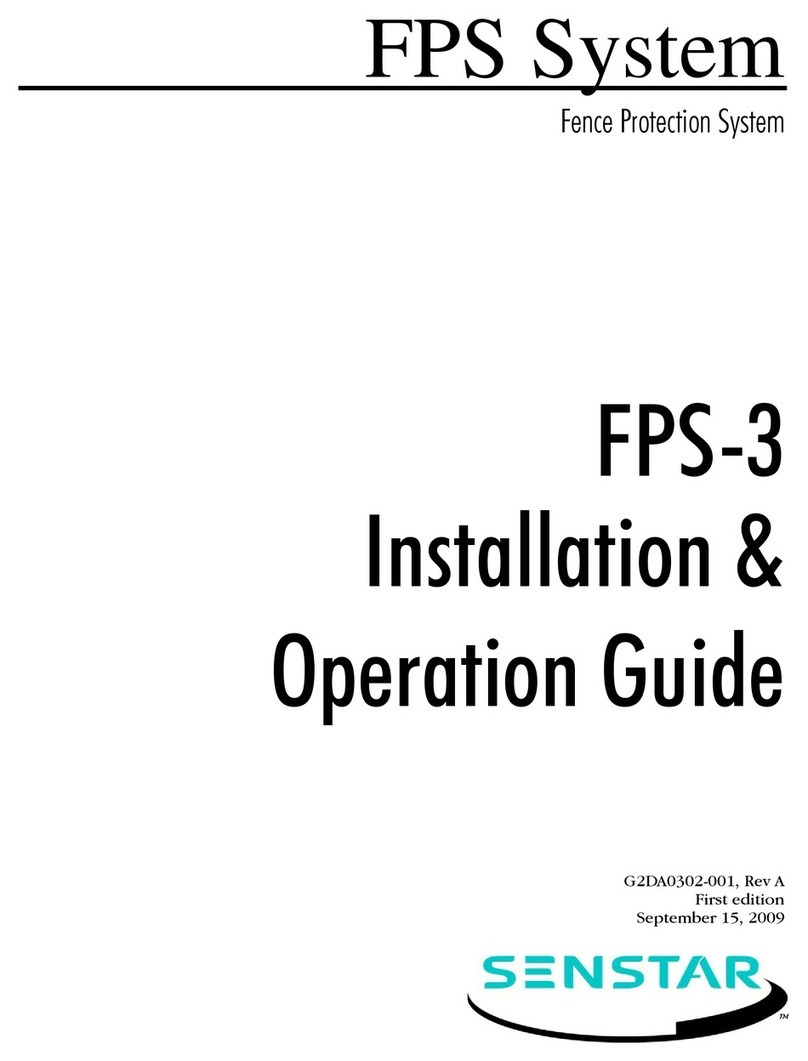
SENSTAR
SENSTAR FPS-3 Installation & operation guide
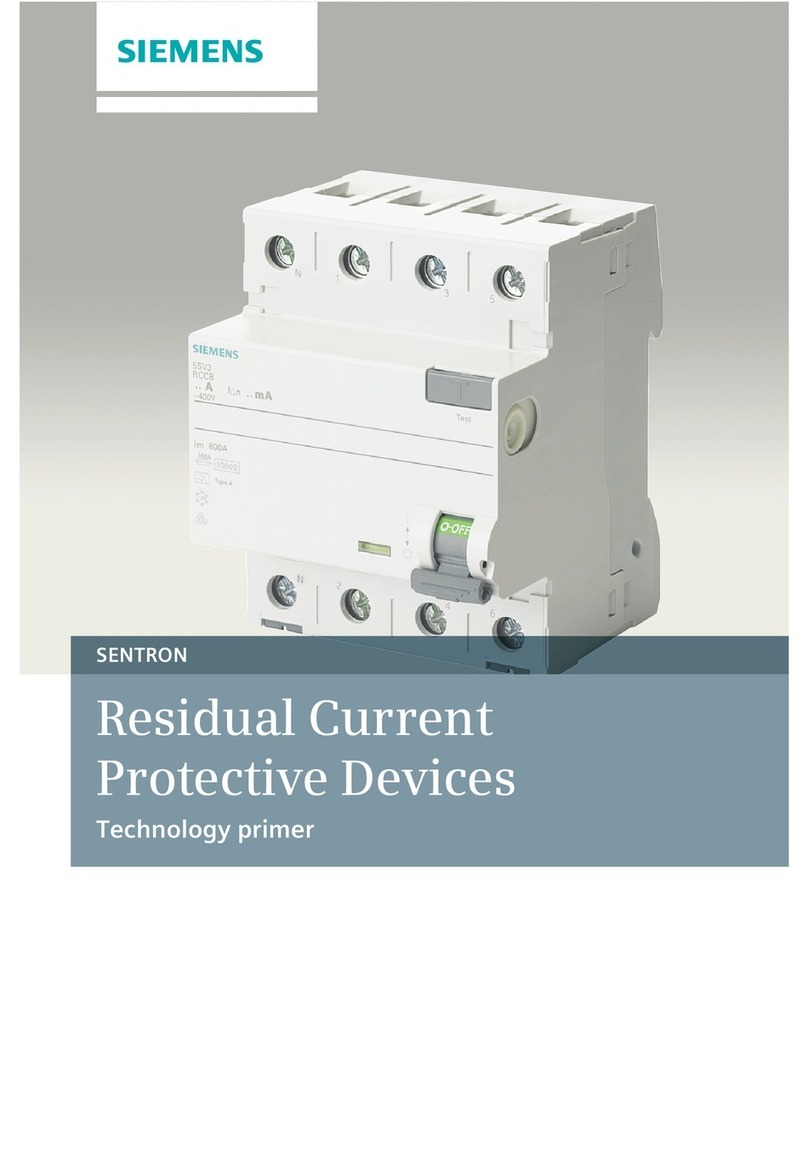
Siemens
Siemens SENTRON instructions

Moeller
Moeller Z-FW-LP installation instructions

SNOWSOUND
SNOWSOUND SIPARIO manual
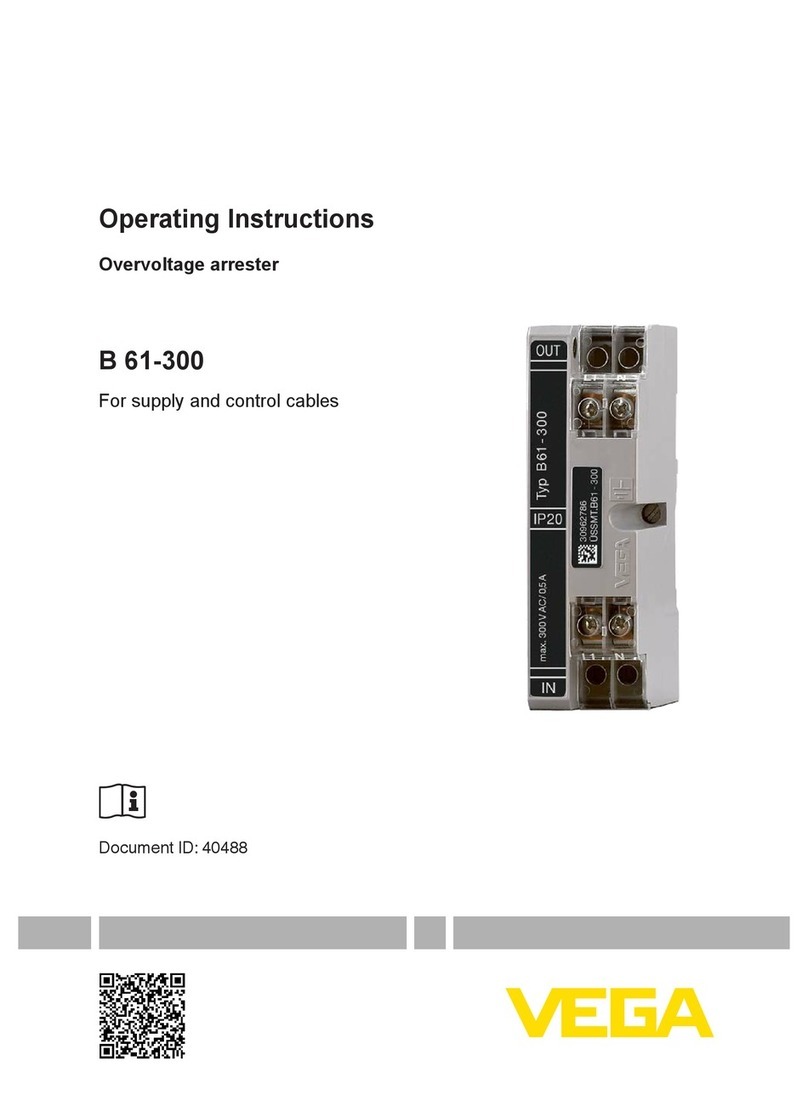
Vega
Vega B 61-300 operating instructions
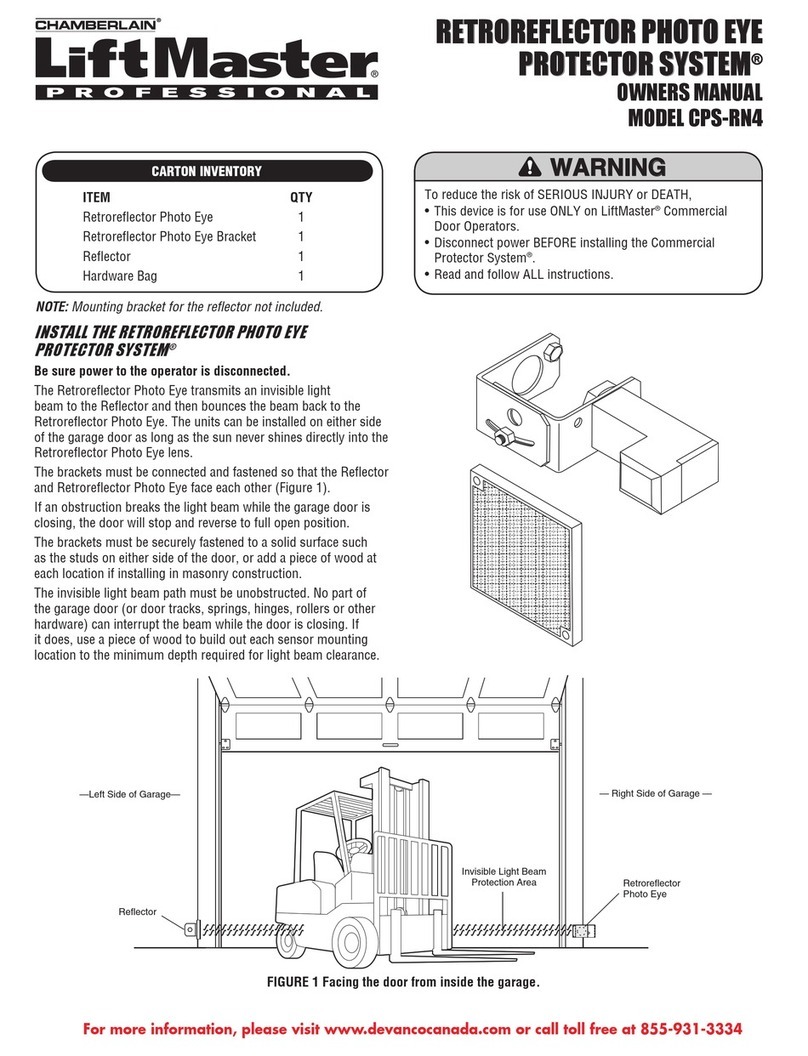
Chamberlain
Chamberlain LiftMaster Professional Retroreflector Photo Eye Protector System... owner's manual
